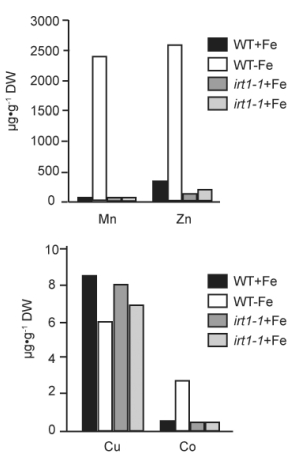 } \text { of iron for 5 days. DW = dry weight} Figure 36.2 -The IRT1 gene is responsible for most of the iron uptake activity in roots Vert et al., Plant Cell 14 [2002]:1223- 33) . To determine the specificity of the IRT1 transporter in Arabidopsis plants, researchers measured the concentration of manganese, zinc, copper, and cobalt contained in wild- type and irt1- 1 mutant plants. What conclusions about IRT1 specificity can you draw from the above data? A) IRT1 participates in the transport of iron, zinc, manganese, and cobalt independent of iron concentration. B) Under iron- deficient conditions, IRT1 is important for the transport of iron and copper. C) IRT1 is important for the transport of iron and copper independent of iron concentration. D) Under iron- deficient conditions, IRT1 is highly specific for Fe. E) Under iron- deficient conditions, IRT1 is necessary for the transport of iron, zinc, manganese, and cobalt. " class="answers-bank-image d-inline" rel="preload" >
} \text { of iron for 5 days. DW = dry weight} Figure 36.2 -The IRT1 gene is responsible for most of the iron uptake activity in roots Vert et al., Plant Cell 14 [2002]:1223- 33) . To determine the specificity of the IRT1 transporter in Arabidopsis plants, researchers measured the concentration of manganese, zinc, copper, and cobalt contained in wild- type and irt1- 1 mutant plants. What conclusions about IRT1 specificity can you draw from the above data? A) IRT1 participates in the transport of iron, zinc, manganese, and cobalt independent of iron concentration. B) Under iron- deficient conditions, IRT1 is important for the transport of iron and copper. C) IRT1 is important for the transport of iron and copper independent of iron concentration. D) Under iron- deficient conditions, IRT1 is highly specific for Fe. E) Under iron- deficient conditions, IRT1 is necessary for the transport of iron, zinc, manganese, and cobalt. " class="answers-bank-image d-inline" rel="preload" >
Figure 36.2
-The IRT1 gene is responsible for most of the iron uptake activity in roots Vert et al., Plant Cell 14
[2002]:1223- 33) . To determine the specificity of the IRT1 transporter in Arabidopsis plants, researchers measured the concentration of manganese, zinc, copper, and cobalt contained in wild- type and irt1- 1 mutant plants.
What conclusions about IRT1 specificity can you draw from the above data?
Definitions:
Sleep Terrors
A sleep disorder causing feelings of terror or dread, commonly involving screaming, flailing, and intense fear during sleep, more often in children.
Somnambulism
A sleep disorder known as sleepwalking, where the person walks or performs other complex behaviors while still asleep.
Deep Sleep
A stage of sleep characterized by slow brain waves, known as delta waves, during which the body repairs and regrows tissues, builds bone and muscle, and strengthens the immune system.
Preoperational Stage
The second stage in Piaget’s scheme, characterized by inflexible and irreversible mental manipulation of symbols.
Q3: Bacteria participate in the nitrogen cycle through
Q4: Due to its unusual habitat inside the
Q19: Which of these is not an example
Q24: Which of the following is correct?<br>A) During
Q25: How would you expect the root system
Q26: Arrange the following in the correct sequence,
Q29: Which class of tissue has many different
Q39: A neurophysiologist is investigating nerve reflexes in
Q43: Mammals and birds eat more often than
Q43: What do sharks use the ampullae of